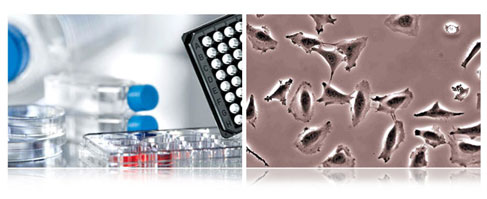Tissue culture is not a new technique − in the scientific literature there are references to its use dating back to 1885. An embryologist, called Roux, was able to maintain the medullary plate of a chick embryo in warm saline for a few days. This was the first recorded example of successful explantation. In 1903, Jolly made detailed observations on in vitro cell survival and cell division using salamander leukocytes. In the early experiments, fragments of tissue were studied, and this gave rise to the name 'tissue culture'. Officially, the term tissue culture is used when cells are maintained in vitro for more than 24 hours.
The development of animal cell culture can be traced back to the work of Ross Harrison in 1907 on cell entrapment and growth from explants of frog embryo tissue. The cell growth that he observed in clotted lymph fluid in a depression slide is often regarded as the foundation of animal cell culture as a science. In his technique ('the hanging drop') the isolated tissue was suspended on the underside of a coverslip which was sealed over a depression in a microscope slide. Burrows continued the development of this technique with the use of plasma clots which were found to be more efficient for the growth of cells from warm-blooded animals. The matrix of insoluble protein provided the necessary anchor for cell growth, and nutrients were provided by the enclosed fluid.
One of the major difficulties of this work was the maintenance of the cultures free from contamination. The difference in growth rates between animal and bacterial cells is such that a low-level contamination in an animal cell culture can quickly lead to bacterial overgrowth. This led Alexis Carrel, who was trained as a surgeon, to apply strict aseptic techniques to cell culture in vitro. He introduced the 'Carrel flask' which facilitated subculture under aseptic conditions and became the forerunner of modern tissue culture flasks. However, the procedures were elaborate and difficult to repeat and so cell culture was not adopted as a routine laboratory technique until much later.
In 1912, Carrel initiated a culture of chick embryo heart cells which were passaged for a reported period of 34 years. This led to the erroneous belief that, given the appropriate conditions, isolated cells could be cultured indefinitely. Later, analysis of Carrel's work showed that, as cell growth was maintained by the use of embryo extracts, new cells were being continuously added to the culture during medium replenishment. The finite capacity for growth of 'normal' cells was eventually established from the work of Hayflick and Moorhead in 1961.
Another significant advance was the use of trypsin (a proteolytic enzyme) by Rous and Jones in 1916 to free cells from tissue matrix. It was subsequently used for the subculture of adherent cells and in the 1950s, the technique of trypsinization was exploited to produce homogeneous cell strains (as opposed to tissue cultures which contain a mixture of cell types) and this marked the start of animal cell culture techniques. Trypsinization is the term applied to the treatment of cells by the proteolytic enzyme trypsin to change their adhesiveness. The term 'cell culture' refers to cultures derived from dispersed cells taken from the original tissue. In cell culture the cells are no longer organized into tissues.
To meet the nutritional requirements of cells, embryo extracts or animal blood serum were added to the cells. These were particularly vulnerable to contamination but the addition of the antibiotics, penicillin and streptomycin, to the cell culture medium from the 1940s onwards alleviated this problem. The problems of microbial contamination have also been greatly reduced by the use of laminar air flow cabinets, which minimize the possibility of contamination by air-borne microbes. This encouraged the more widespread use of cell culture as a laboratory technique, particularly after the isolation of a variety of cell types which showed good growth characteristics in vitro. These included the chemically transformed mouse L cells and the human carcinoma cell line, HeLa.
These cell lines were the focus of Earle and Eagle's work in the 1950s on the development of chemically defined media. The nutrient formulations developed replaced the undefined biological extracts previously used. This had the advantages of consistency between batches, ease of sterilization, and reduced chance of contamination.
The impetus for the application of the techniques of cell culture on a laboratory scale to large industrial scale processes came with the capability of virus propagation on cell culture. The polio vaccine which was produced for mass vaccination in the 1950s became one of the first major commercial products of cultured animal cells. Since the 1950s a range of other products synthesized from animal cells have found commercial application. Consequently, the study of the optimization of culture conditions to maintain consistently high productivity from such animal cells in vitro has become of increased importance.
Nowadays, animal cell culture becomes a reasonable alternative for animal experiments in the process of drug discovery and development. Overall, an aspect of pharmaceutical research which promisingly employs cell culture models is the study of in vitro drug transport/absorption and metabolism.
